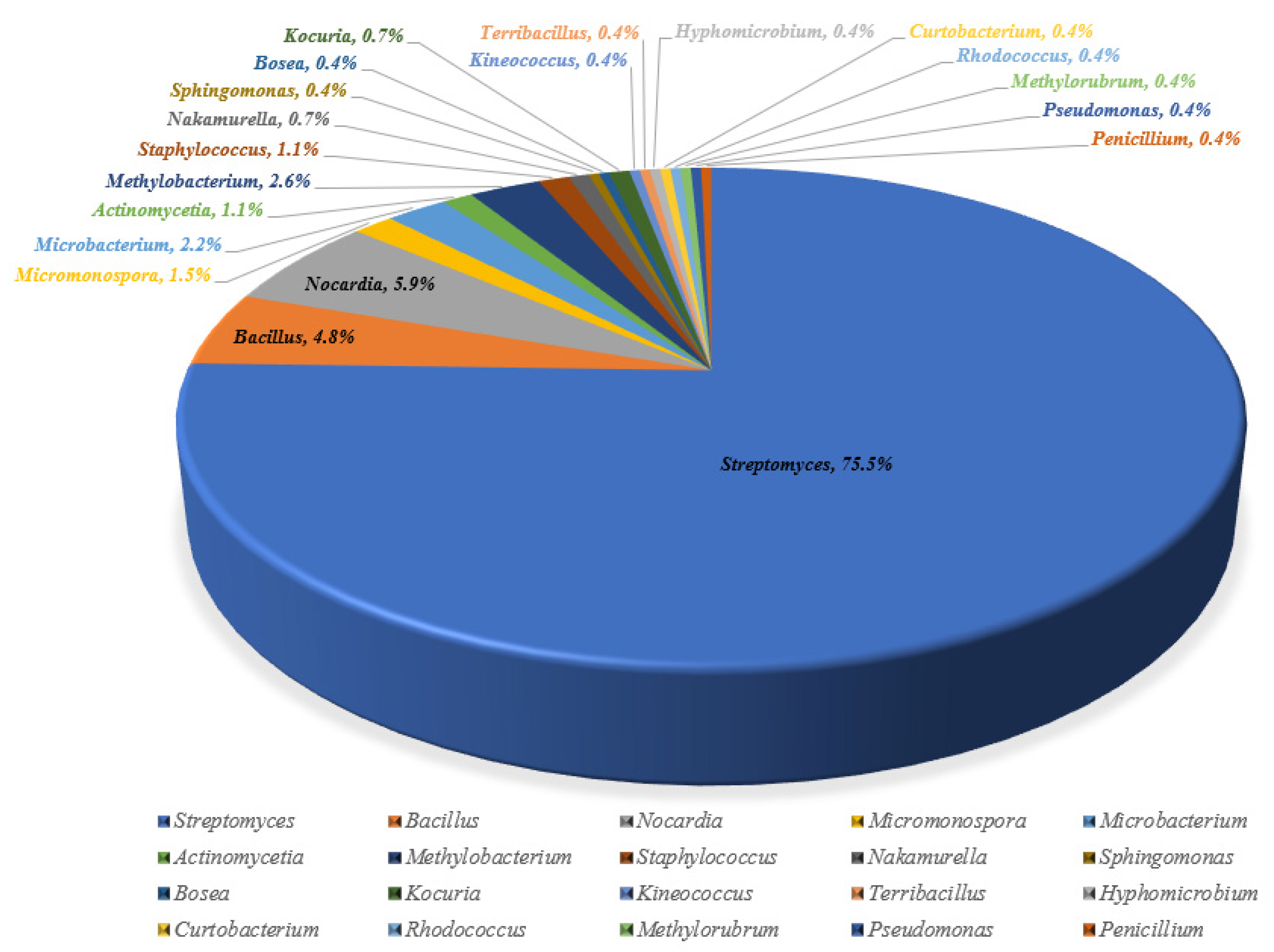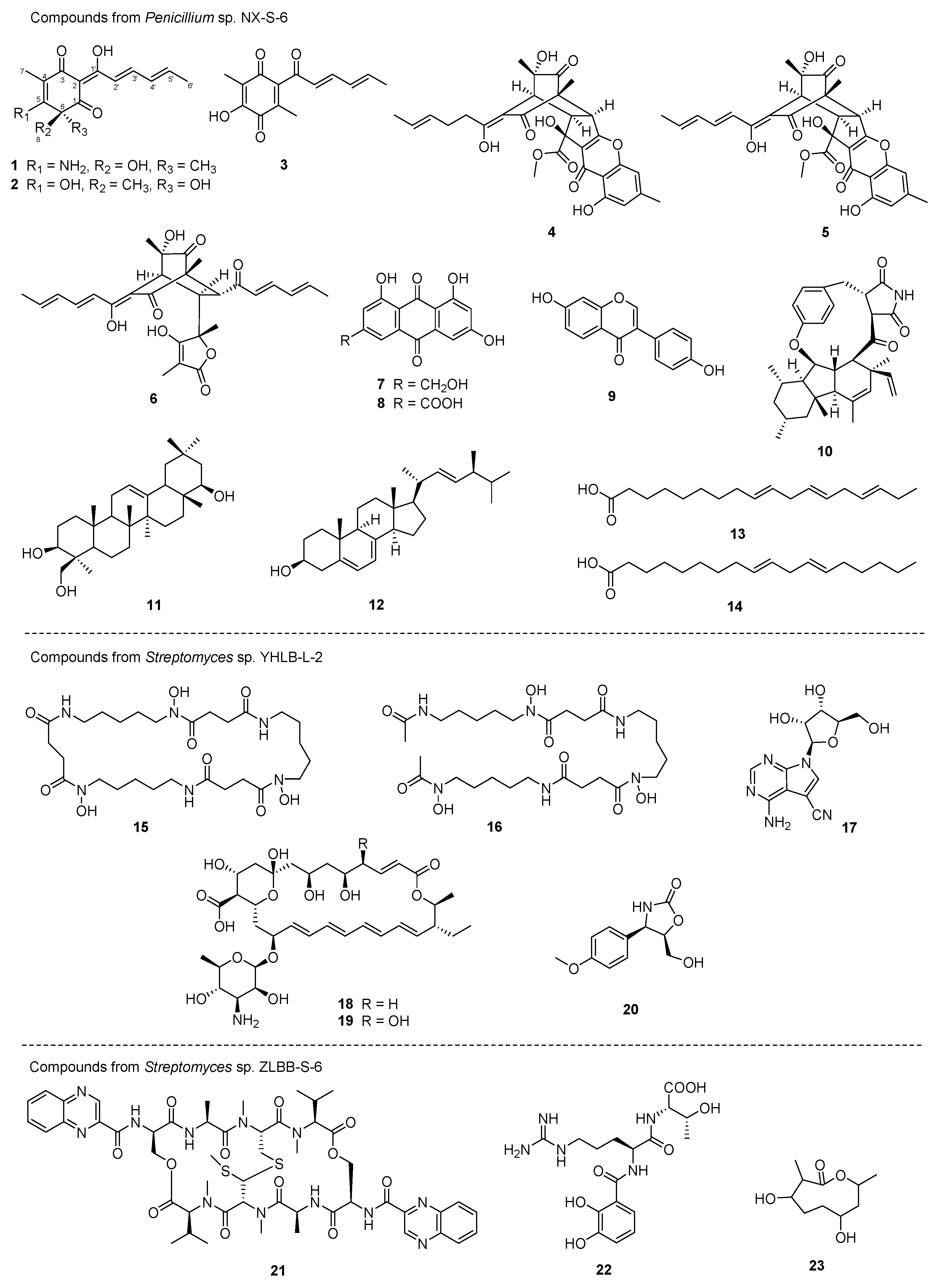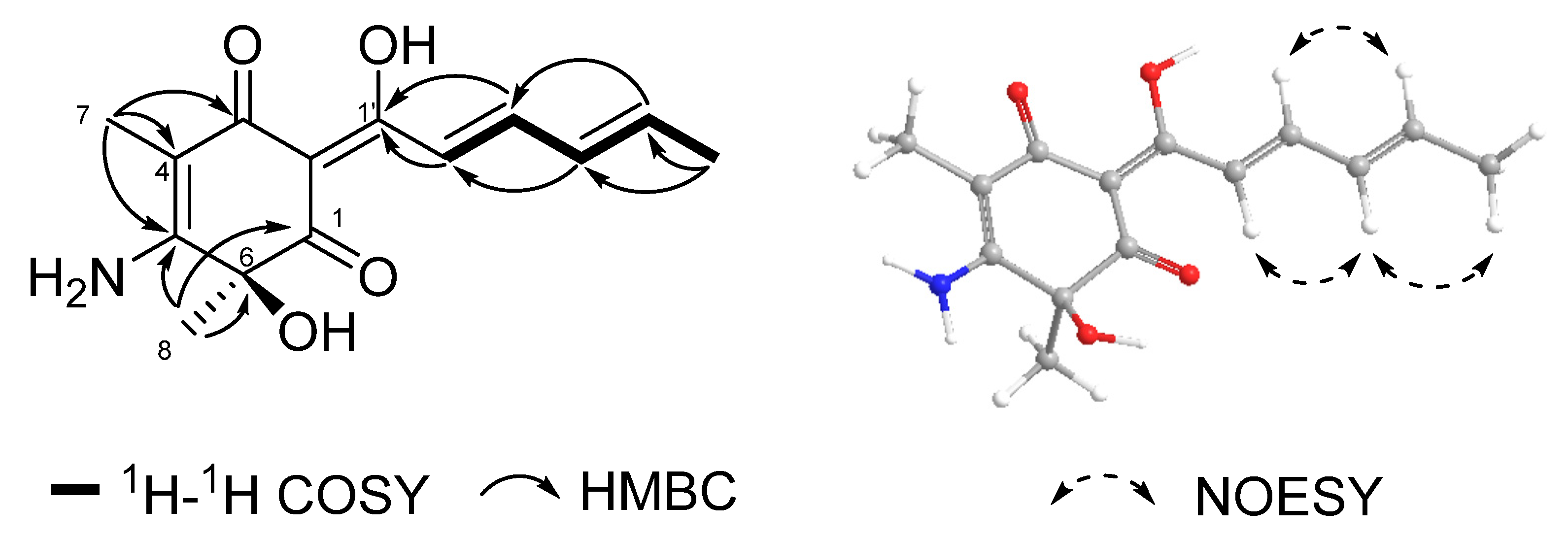Endophytic Microbes from Medicinal Plants in Fenghuang Mountain as a Source of Antibiotics
Abstract
:1. Introduction
2. Results
2.1. Endophytic Strain Isolation and Identification
2.2. Strain Prioritization
2.3. Scale-Up Fermentation and Isolation
2.4. Structure Elucidation
2.5. Antimicrobial Results
3. Discussion and Conclusions
4. Materials and Methods
4.1. General Experimental Procedures
4.2. Culture Media
4.3. Endophytic Strain Isolation
4.4. Phylogenetic Analysis
4.4.1. 16S rRNA Sequence for Bacteria
4.4.2. ITS Sequence for Fungus
4.5. Strain Prioritization
4.5.1. Small Scale Fermentation and Extraction
4.5.2. HPLC-MS Analysis
4.5.3. Preliminary Antimicrobial Activities Screening
4.6. Fermentation, Extraction and Isolation
4.6.1. Penicillium sp. NX-S-6
4.6.2. Streptomyces sp. YHLB-L-2
4.6.3. Streptomyces sp. ZLBB-S-6
4.7. Computational Methods
4.8. Antimicrobial Assay
4.8.1. Antibacterial Activity
4.8.2. Antifungal Activity
Supplementary Materials
Author Contributions
Funding
Institutional Review Board Statement
Informed Consent Statement
Data Availability Statement
Conflicts of Interest
Sample Availability
References
- Darby, E.M.; Trampari, E.; Siasat, P.; Gaya, M.S.; Alav, I.; Webber, M.A.; Blair, J.M.A. Molecular mechanisms of antibiotic resistance revisited. Nat. Rev. Microbiol. 2023, 21, 280–295. [Google Scholar] [CrossRef]
- Newman, D.J.; Cragg, G.M. Natural products as sources of new drugs over the nearly four decades from 01/1981 to 09/2019. J. Nat. Prod. 2020, 83, 770–803. [Google Scholar] [CrossRef]
- Tiwari, P.; Kang, S.; Bae, H. Plant-endophyte associations: Rich yet under-explored sources of novel bioactive molecules and applications. Microbiol. Res. 2023, 266, 127241. [Google Scholar] [CrossRef]
- Stierle, A.; Strobel, G.; Stierle, D. Taxol and taxane production by Taxomyces andreanae, an endophytic fungus of Pacific yew. Science 1993, 260, 214–216. [Google Scholar] [CrossRef]
- Muthukrishnan, S.; Prakathi, P.; Sivakumar, T.; Thiruvengadam, M.; Jayaprakash, B.; Baskar, V.; Rebezov, M.; Derkho, M.; Zengin, G.; Shariati, M.A. Bioactive components and health potential of endophytic micro-fungal diversity in medicinal plants. Antibiotics 2022, 11, 1533. [Google Scholar] [CrossRef]
- Newman, D.J.; Cragg, G.M. Plant Endophytes and epiphytes: Burgeoning sources of known and “unknown” cytotoxic and antibiotic agents? Planta Med. 2020, 86, 891–905. [Google Scholar] [CrossRef]
- Zhao, H.; Yang, A.; Zhang, N.; Li, S.; Yuan, T.; Ding, N.; Zhang, S.; Bao, S.; Wang, C.; Zhang, Y.; et al. Insecticidal endostemonines A-J produced by endophytic Streptomyces from Stemona sessilifolia. J. Agric. Food Chem. 2020, 68, 1588–1595. [Google Scholar] [CrossRef]
- Zhao, K.; Penttinen, P.; Guan, T.; Xiao, J.; Chen, Q.; Xu, J.; Lindstrom, K.; Zhang, L.; Zhang, X.; Strobel, G.A. The diversity and anti-microbial activity of endophytic actinomycetes isolated from medicinal plants in Panxi plateau, China. Curr. Microbiol. 2011, 62, 182–190. [Google Scholar] [CrossRef]
- Raja, A.; Prabakarana, P. Actinomycetes and drug—An overview. Am. J. Drug Discov. Dev. 2011, 1, 75–84. [Google Scholar] [CrossRef]
- Liu, S.J.; Yan, H.; Duan, J.A.; Zhan, G.S.; Ao, W.; Wu, Q.N.; Dai, S.L.; Yan, B.F.; Zhu, X.Y. Distribution of medicinal mineral resources in Jiangsu Province and their utilization status and prospects. Chin. Tradit. Herb. Drugs 2020, 51, 1628–1640. [Google Scholar]
- Ding, N.; Wang, J.; Liu, J.; Zhu, Y.; Hou, S.; Zhao, H.; Yang, Y.; Chen, X.; Hu, L.; Wang, X. Cytotoxic guaianolide sesquiterpenoids from Ainsliaea fragrans. J. Nat. Prod. 2021, 84, 2568–2574. [Google Scholar] [CrossRef]
- Wang, J.; Li, H.; Li, Y.; Yang, A.; Bao, S.; Zhang, Y.; Du, Q.; Zheng, Z.; Wang, X. Sinoflavonoids NJ and NK, anti-inflammatory prenylated flavonoids from the fruits of Podophyllum hexandrum Royle. Nat. Prod. Res. 2023. [Google Scholar] [CrossRef]
- Zhu, Y.; Kong, Y.; Hong, Y.; Zhang, L.; Li, S.; Hou, S.; Chen, X.; Xie, T.; Hu, Y.; Wang, X. Huoshanmycins A–C, new polyketide dimers produced by endophytic Streptomyces sp. HS-3-L-1 from Dendrobium huoshanense. Front. Chem. 2021, 9, 807508. [Google Scholar] [CrossRef]
- Zhao, H.; Yang, A.; Liu, J.; Bao, S.; Peng, R.; Hu, Y.; Yuan, T.; Hou, S.; Xie, T.; Zhang, Q.; et al. Chartspiroton, a tetracyclic spiro-naphthoquinone derivative from a medicinal plant endophytic Streptomyces. Org. Lett. 2020, 22, 3739–3743. [Google Scholar] [CrossRef]
- Abe, N.; Yamamoto, K.; Hirota, A. Novel fungal metabolites, demethylsorbicillin and oxosorbicillinol, isolated from Trichoderma sp. USF-2690. Biosci. Biotechnol. Biochem. 2000, 64, 620–622. [Google Scholar] [CrossRef]
- Miller, R.F.; Huang, S. Isolation and structure of sorrentanone: A new tetrasubstituted quinone from Penicillium chrysogenum. J. Antibiot. 1995, 48, 520–521. [Google Scholar] [CrossRef] [PubMed]
- Pang, X.; Wang, P.; Liao, S.; Zhou, X.; Lin, X.; Yang, B.; Tian, X.; Wang, J.; Liu, Y. Three unusual hybrid sorbicillinoids with anti-inflammatory activities from the deep-sea derived fungus Penicillium sp. SCSIO06868. Phytochemistry 2022, 202, 113311. [Google Scholar] [CrossRef] [PubMed]
- Abe, N.; Murata, T.; Hirota, A. Novel oxidized sorbicillin dimers with 1,1-diphenyl-2-picrylhydrazyl-radical scavenging activity from a fungus. Biosci. Biotechnol. Biochem. 1998, 62, 2120–2126. [Google Scholar] [CrossRef] [PubMed]
- Hirose, Y.; Suehiro, Y.; Furukawa, Y.; Murakami, T.J.C.; Bulletin, P. Chemische studien uber naturliche Anthrachinone. II. Synthese von citreoroseine, fallacinol und fallacinal. Chem. Pharm. Bull. 1982, 30, 4186–4188. [Google Scholar] [CrossRef]
- Anslow, W.K.; Breen, J.; Raistrick, H. Studies in the biochemistry of micro-organisms: Emodic acid (4:5:7-trihydroxyanthraquinone-2-carboxylic acid) and omega-hydroxyemodin (4:5:7-trihydroxy-2-(hydroxymethyl)-anthraquinone), metabolic products of a strain of Penicillium cyclopium Westling. Biochem. J. 1940, 34, 159–168. [Google Scholar] [CrossRef]
- Khamthong, N.; Rukachaisirikul, V.; Tadpetch, K.; Kaewpet, M.; Phongpaichit, S.; Preedanon, S.; Sakayaroj, J. Tetrahydroanthraquinone and xanthone derivatives from the marine-derived fungus Trichoderma aureoviride PSU-F95. Arch. Pharm. Res. 2012, 35, 461–468. [Google Scholar] [CrossRef] [PubMed]
- Fujimoto, H.; Nakamura, E.; Okuyama, E.; Ishibashi, M. Six immunosuppressive features from an ascomycete, Zopfiella longicaudata, found in a screening study monitored by immunomodulatory activity. Chem. Pharm. Bull. 2004, 52, 1005–1008. [Google Scholar] [CrossRef] [PubMed]
- Alvi, K.A.; Nair, B.; Gallo, C.; Baker, D. Screening of microbial extracts for tyrosine kinase inhibitors. J. Antibiot. 1997, 50, 264–266. [Google Scholar] [CrossRef]
- Hirakura, K.; Morita, M.; Nakajima, K.; Sugama, K.; Takagi, K.; Niitsu, K.; Ikeya, Y.; Maruno, M.; Okada, M.J.P. Phenolic glucosides from the root of Pueraria lobata. Phytochemistry 1997, 46, 921–928. [Google Scholar] [CrossRef]
- Gutierrez-Lugo, M.T.; Woldemichael, G.M.; Singh, M.P.; Suarez, P.A.; Maiese, W.M.; Montenegro, G.; Timmermann, B.N. Isolation of three new naturally occurring compounds from the culture of Micromonospora sp. P1068. Nat. Prod. Res. 2005, 19, 645–652. [Google Scholar] [CrossRef]
- Pastre, R.; Marinho, A.M.; Rodrigues-Filho, E.; Souza, A.Q.; Pereira, J.O. Diversidade de policetídeos produzidos por espécies de Penicillium isoladas de Melia azedarach e murraya paniculata. Quím. Nova 2007, 30, 1867–1871. [Google Scholar] [CrossRef]
- Macías, F.; Simonet, A.M.; Esteban, M.; Galindo, J.J.P. Triterpenoids from Melilotus messanensis; soyasapogenol G, the first natural carbonate derivative. Phytochemistry 1996, 41, 1573–1577. [Google Scholar] [CrossRef]
- Chiang, T.C.; Chang, H.M. Isolation and structural elucidation of some sapogenols from Abrus cantoniensis. Planta Med. 1982, 46, 52–55. [Google Scholar] [CrossRef]
- Wu, M.; Shen, C.E.; Lin, Q.F.; Zhong, J.Y.; Zhou, Y.F.; Liu, B.C.; Xu, J.H.; Zhang, Z.Q.; Li, P. Sterols and triterpenoids from Ganoderma lucidum and their reversal activities of tumor multidrug resistance. Nat. Prod. Res. 2022, 36, 1396–1399. [Google Scholar] [CrossRef]
- Cushley, R.J.; Filipenko, J.D. 13C fourier transform n.m.r.: XIII—Reassignment of the 13C spectrum of ergosterol. Org. Magn. Reson. 1976, 8, 308–309. [Google Scholar] [CrossRef]
- Alamsjah, M.A.; Hirao, S.; Ishibashi, F.; Fujita, Y. Isolation and structure determination of algicidal compounds from Ulva fasciata. Biosci. Biotechnol. Biochem. 2005, 69, 2186–2192. [Google Scholar] [CrossRef] [PubMed]
- Wang, Y.Y.; Liang, X.; Zhong, H.M. Chemical constituents of Lysimachia stenosepal. Chin. J. Med. Chem. 2012, 22, 47–50. [Google Scholar]
- Acquah, K.S.; Beukes, D.R.; Warner, D.F.; Meyers, P.R.; Sunassee, S.N.; Maglangit, F.; Deng, H.; Jaspars, M.; Gammon, D.W. Novel South African rare Actinomycete Kribbella speibonae Strain SK5: A prolific producer of hydroxamate siderophores including new dehydroxylated congeners. Molecules 2020, 25, 2979. [Google Scholar] [CrossRef] [PubMed]
- Zhu, Y.; Li, S.; Kong, Y.; Zhao, H.; Hu, Y.; Meng, J.; Chen, X.; Hou, S.; Wang, X. Terragines F-G produced by endophytic Bacillus sp. SH-1.2-ROOT-18 from Dendrobium officinale. Nat. Prod. Res. 2022, 36, 5058–5063. [Google Scholar] [CrossRef] [PubMed]
- Zabriskie, T.M.; Ireland, C.M. The isolation and structure of modified bioactive nucleosides from Jaspis johnstoni. J. Nat. Prod. 1989, 52, 1353–1356. [Google Scholar] [CrossRef]
- Dornberger, K.; Thrum, H.; Radics, L. The structure of tetramycin, a new polyene macrolide antibiotic. Tetrahedron 1979, 35, 1851–1856. [Google Scholar] [CrossRef]
- Radics, L.; Incze, M.; Dornberger, K.; Thrum, H.J.T. Tetramycin B, a new polyene macrolide antibiotic. Tetrahedron 1982, 38, 183–189. [Google Scholar] [CrossRef]
- Kakeya, H.; Morishita, M.; Koshino, H.; Morita Ti, T.I.; Kobayashi, K.; Osada, H. Cytoxazone: A novel cytokine modulator containing a 2-oxazolidinone ring produced by Streptomyces sp. J. Org. Chem. 1999, 64, 1052–1053. [Google Scholar] [CrossRef]
- Shi, J.; Qi, C.; Chen, W. The revision of 1H, 13C-NMR assignments of qinomycins A and C. Chin. J. Antibiot. 1999, 24, 258–261. [Google Scholar]
- Katagiri, K.; Shoji, J.; Yoshisa, T. Identity of levomycin and quinomycin A (echimomycin). J. Antibiot. 1962, 15, 273. [Google Scholar]
- Hatsu, M.; Naganawa, H.; Aoyagi, T.; Takeuchi, T. Benarthin: A new inhibitor of pyroglutamyl peptidase. II. Physico-chemical properties and structure determination. J. Antibiot. 1992, 45, 1084–1087. [Google Scholar] [CrossRef]
- Han, B.; Cui, C.B.; Cai, B.; Ji, X.F.; Yao, X.S. Actinolactomycin, a new 2-oxonanonoidal antitumor antibiotic produced by Streptomyces flavoretus 18522, and its inhibitory effect on the proliferation of human cancer cells. Chin. Chem. Lett. 2005, 16, 471–474. [Google Scholar]
- Liu, Y.; Tang, L.; Wang, C.; Li, J. NAA and 6-BA promote accumulation of oleanolic acid by JA regulation in Achyranthes bidentata Bl. PLoS ONE 2020, 15, e0229490. [Google Scholar] [CrossRef]
- Rangsinth, P.; Sharika, R.; Pattarachotanant, N.; Duangjan, C.; Wongwan, C.; Sillapachaiyaporn, C.; Nilkhet, S.; Wongsirojkul, N.; Prasansuklab, A.; Tencomnao, T.; et al. Potential beneficial effects and pharmacological properties of ergosterol, a common bioactive compound in edible mushrooms. Foods 2023, 12, 2529. [Google Scholar] [CrossRef] [PubMed]
- Cao, V.A.; Kwon, J.H.; Kang, J.S.; Lee, H.S.; Heo, C.S.; Shin, H.J. Aspersterols A-D, ergostane-type sterols with an unusual unsaturated side chain from the deep-sea-derived fungus Aspergillus unguis. J. Nat. Prod. 2022, 85, 2177–2183. [Google Scholar] [CrossRef]
- Ma, D.; Zhu, J.; Jiang, J.; Zhao, Y.; Li, B.; Mu, W.; Liu, F. Evaluation of bioactivity and control efficacy of tetramycin against Corynespora cassiicola. Pestic. Biochem. Phys. 2018, 152, 106–113. [Google Scholar] [CrossRef] [PubMed]
- Pan, X.; Li, Y.; Yu, S.; Qi, H.; Liu, Y.; Wang, X.; Wang, J.; Zhang, Y.; Ma, Z. Tetramycins C-E, three new tetraene macrolides from Streptomyces ahygroscopicus Z117. Tetrahedron Lett. 2023, 119, 154425. [Google Scholar] [CrossRef]
- Waring, M.J.; Wakelin, L.P. Echinomycin: A bifunctional intercalating antibiotic. Nature 1974, 252, 653–657. [Google Scholar] [CrossRef]
- Chen, J.; Lin, Z.; Song, J.; Plaisance-Bonstaff, K.; James, J.; Mu, S.; Post, S.R.; Dai, L.; Qin, Z. Echinomycin as a promising therapeutic agent against KSHV-related malignancies. J. Hematol. Oncol. 2023, 16, 48. [Google Scholar] [CrossRef]
- Wang, Y.; Liu, Y.; Tang, F.; Bernot, K.M.; Schore, R.; Marcucci, G.; Caligiuri, M.A.; Zheng, P.; Liu, Y. Echinomycin protects mice against relapsed acute myeloid leukemia without adverse effect on hematopoietic stem cells. Blood 2014, 124, 1127–1135. [Google Scholar] [CrossRef]
- Shevrin, D.H.; Lad, T.E.; Guinan, P.; Kilton, L.J.; Greenburg, A.; Johnson, P.; Blough, R.R.; Hoyer, H. Phase II trial of echinomycin in advanced hormone-resistant prostate cancer. An Illinois Cancer Council study. Investig. New Drugs 1994, 12, 65–66. [Google Scholar] [CrossRef]
- Schilsky, R.L.; Faraggi, D.; Korzun, A.; Vogelzang, N.; Ellerton, J.; Wood, W.; Henderson, I.C. Phase II study of echinomycin in patients with advanced breast cancer: A report of Cancer and Leukemia Group B protocol 8641. Investig. New Drugs 1991, 9, 269–272. [Google Scholar] [CrossRef]
- Marshall, M.E.; Wolf, M.K.; Crawford, E.D.; Taylor, S.; Blumenstein, B.; Flanigan, R.; Meyers, F.J.; Hynes, H.E.; Barlogie, B.; Eisenberger, M. Phase II trial of echinomycin for the treatment of advanced renal cell carcinoma. A Southwest Oncology Group study. Investig. New Drugs 1993, 11, 207–209. [Google Scholar] [CrossRef] [PubMed]
- Lim, C.L.; Nogawa, T.; Uramoto, M.; Okano, A.; Hongo, Y.; Nakamura, T.; Koshino, H.; Takahashi, S.; Ibrahim, D.; Osada, H. RK-1355A and B, novel quinomycin derivatives isolated from a microbial metabolites fraction library based on NPPlot screening. J. Antibiot. 2014, 67, 323–329. [Google Scholar] [CrossRef]
- Watanabe, K.; Hotta, K.; Nakaya, M.; Praseuth, A.P.; Wang, C.C.; Inada, D.; Takahashi, K.; Fukushi, E.; Oguri, H.; Oikawa, H. Escherichia coli allows efficient modular incorporation of newly isolated quinomycin biosynthetic enzyme into echinomycin biosynthetic pathway for rational design and synthesis of potent antibiotic unnatural natural product. J. Am. Chem. Soc. 2009, 131, 9347–9353. [Google Scholar] [CrossRef] [PubMed]
- Strobel, G.A. Endophytes as sources of bioactive products. Microbes Infect. 2003, 5, 535–544. [Google Scholar] [CrossRef]
- Zhao, H.; Chen, X.; Chen, X.; Zhu, Y.; Kong, Y.; Zhang, S.; Deng, X.; Ouyang, P.; Zhang, W.; Hou, S.; et al. New peptidendrocins and anticancer chartreusin from an endophytic bacterium of Dendrobium officinale. Ann. Transl. Med. 2020, 8, 455. [Google Scholar] [CrossRef]
- Wang, X.; Shaaban, K.A.; Elshahawi, S.I.; Ponomareva, L.V.; Sunkara, M.; Zhang, Y.; Copley, G.C.; Hower, J.C.; Morris, A.J.; Kharel, M.K.; et al. Frenolicins C-G, pyranonaphthoquinones from Streptomyces sp. RM-4-15. J. Nat. Prod. 2013, 76, 1441–1447. [Google Scholar] [CrossRef]
- Gardes, M.; Bruns, T.D. ITS primers with enhanced specificity for basidiomycetes—Application to the identification of mycorrhizae and rusts. Mol. Ecol. 1993, 2, 113–118. [Google Scholar] [CrossRef] [PubMed]
- Frisch, M.J.; Trucks, G.W.; Schlegel, H.B.; Scuseria, G.E.; Robb, M.A.; Cheeseman, J.R.; Scalmani, G.; Barone, V.; Mennucci, B.; Petersson, G.A.; et al. Gaussian 09, Rev. B.01; Gaussian, Inc.: Wallingford, CT, USA, 2010. [Google Scholar]
- Bruhn, T.; Schaumloeffel, A.; Hemberger, Y.; Bringmann, G. SpecDis: Quantifying the comparison of calculated and experimental electronic circular dichroism spectra. Chirality 2013, 25, 243–249. [Google Scholar] [CrossRef] [PubMed]
- Lodewyk, M.W.; Siebert, M.R.; Tantillo, D.J. Computational prediction of 1H and 13C chemical shifts: A useful tool for natural product, mechanistic, and synthetic organic chemistry. Chem. Rev. 2012, 112, 1839. [Google Scholar] [CrossRef] [PubMed]



| Host Plants | Endophyte Numbers |
|---|---|
| Achyranthes bidentata | 124 |
| Ainsliaea fragrans | 13 |
| Artemisia capillaris | 11 |
| Daucus carota | 13 |
| Leonurus japonicus | 21 |
| Perilla frutescens | 15 |
| Prunella vulgris | 28 |
| Salvia miltiorrhiza | 16 |
| Stemona sessilifolia | 28 |
| Total | 269 |
| No. | 1 1 | 2 2 | ||
|---|---|---|---|---|
| δC, Type | δH (J in Hz) | δC, Type | δH (J in Hz) | |
| 1 | 196.5, C | 196.5, C | ||
| 2 | 103.4, C | 104.0, C | ||
| 3 | 187.9, C | 191.3, C | ||
| 4 | 97.3, C | 105.0, C | ||
| 5 | 163.5, C | 174.1, C | ||
| 6 | 75.0, C | 75.1, C | ||
| 7 | 7.6, CH3 | 1.80, s | 7.8, CH3 | 1.73, s |
| 8 | 32.8, CH3 | 1.58, s | 28.1, CH3 | 1.40, s |
| 1’ | 185.1, C | 184.1, C | ||
| 2’ | 123.8, CH | 7.34, d (15.1) | 123.8, CH | 7.36, d (15.2) |
| 3’ | 144.1, CH | 7.48, dd, (15.1, 11.0) | 144.7, CH | 7.46, dd, (15.2, 9.6) |
| 4’ | 131.2, CH | 6.35, dd, (14.5, 11.0) | 131.4, CH | 6.41, dd, (15.6, 9.6) |
| 5’ | 140.4, CH | 6.21, dq, (14.6, 6.7) | 142.1, CH | 6.38, dq, (15.6, 5.4) |
| 6’ | 18.9, CH3 | 1.89, d (6.7) | 19.2, CH3 | 1.88, d (5.4) |
| Bacteria | 3 | 8 | 10 | 14 | 17 | 21 | AMP | PB |
|---|---|---|---|---|---|---|---|---|
| S. aureus | 128 | 8 | 128 | 64 | - | 0.5 | 16 | - |
| B. subtilis | 32 | 64 | 4 | 32 | - | <0.125 | 64 | 32 |
| E. coli | - | - | - | - | - | 16 | - | 4 |
| A. baumannii | - | 64 | - | - | - | <1 | - | 1 |
| P. aeruginosa | - | - | - | - | 64 | - | - | <64 |
| Organism | 21 | Itraconazole 1 | |
|---|---|---|---|
| Standard strains | Aspergillus fumigatus | 16 | 1 |
| Candida albicans | >32 | 0.25 | |
| Cryptococcus neoformans | 4 | <0.125 | |
| Clinical isolates (Aspergillus fumigatus) | 176 | 16 | <0.125 |
| 339 | 16 | <0.125 | |
| 353 | >32 | 4 | |
| 331 | >32 | 8 | |
| 77 | >32 | 16 | |
| 185 | >32 | 1 | |
Disclaimer/Publisher’s Note: The statements, opinions and data contained in all publications are solely those of the individual author(s) and contributor(s) and not of MDPI and/or the editor(s). MDPI and/or the editor(s) disclaim responsibility for any injury to people or property resulting from any ideas, methods, instructions or products referred to in the content. |
© 2023 by the authors. Licensee MDPI, Basel, Switzerland. This article is an open access article distributed under the terms and conditions of the Creative Commons Attribution (CC BY) license (https://creativecommons.org/licenses/by/4.0/).
Share and Cite
Yang, A.; Hong, Y.; Zhou, F.; Zhang, L.; Zhu, Y.; Wang, C.; Hu, Y.; Yu, L.; Chen, L.; Wang, X. Endophytic Microbes from Medicinal Plants in Fenghuang Mountain as a Source of Antibiotics. Molecules 2023, 28, 6301. https://doi.org/10.3390/molecules28176301
Yang A, Hong Y, Zhou F, Zhang L, Zhu Y, Wang C, Hu Y, Yu L, Chen L, Wang X. Endophytic Microbes from Medicinal Plants in Fenghuang Mountain as a Source of Antibiotics. Molecules. 2023; 28(17):6301. https://doi.org/10.3390/molecules28176301
Chicago/Turabian StyleYang, Aiping, Yu Hong, Fengjuan Zhou, Ling Zhang, Youjuan Zhu, Chang Wang, Yang Hu, Li Yu, Lihong Chen, and Xiachang Wang. 2023. "Endophytic Microbes from Medicinal Plants in Fenghuang Mountain as a Source of Antibiotics" Molecules 28, no. 17: 6301. https://doi.org/10.3390/molecules28176301
APA StyleYang, A., Hong, Y., Zhou, F., Zhang, L., Zhu, Y., Wang, C., Hu, Y., Yu, L., Chen, L., & Wang, X. (2023). Endophytic Microbes from Medicinal Plants in Fenghuang Mountain as a Source of Antibiotics. Molecules, 28(17), 6301. https://doi.org/10.3390/molecules28176301







